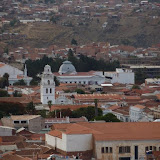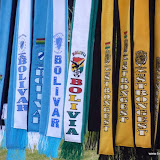After spending a couple of days in Potosi, and with our travel mates, Daniel and Helene, we hit again the Bolivian roads, heading this time for the little town of Uyuni, near the border with Chili.

It took us a little over 6 hours to go through the 250 kilometres of dirt road that links both places. Finally, by mid afternoon, we got near our target and a much desired late lunch. We were so near, we could practically smell the enticing aroma of chicken turning in the grills, a prospect that had our empty stomachs growling and our mouths already watering. A little last turn in the road … and we got face to face with a very common form of protest in Bolivia : road blocks.
As it happens, all the entries and exits of Uyuni were blocked by the truck drivers of the area, that were requesting that part of the transport of minerals from the nearby mines be done by them, rather than all by train.
After waiting two hours and loosing the hope of seeing the problem solved before nightfall we decided, together with some other particular cars, to make a convoy and go off road through the desert to get to the town. When we arrived finally at diner time, we discovered a second 'bloqueo' preventing the access to downtown, by taxi drivers.
The next morning, less than 48 hours after the start of the 'bloqueo', the town felt already like a besieged zone : hotels full, tourists desperate to continue their trip or, like us, to depart for a tour of the surrounding area, which is the main attraction of Uyuni since this overgrown village does not have a lot of interest itself. Most agencies kept running tours on this second day, by leaving the town before daylight to avoid the pickets. But since tank trucks could not get to town, there was no fuel left to ensure all departures on the third day (the few remaining litres were already reaching price records in the black market).
Luckily, we finally found an agency with some fuel left and we could leave for our tour of one of the most beautiful places in Bolivia.
The visit of the area that surrounds Uyuni is done over several days, in a 4x4 truck. It takes you through some amazingly beautiful desert zones of hard dirt roads, sometimes no roads at all, where direction signs have not yet been invented and where car suspensions have a very short life.

Near Uyuni there is the biggest Salt Flat worldwide. The region, covered by the Atlantic Ocean at the origin, became a lake when the Andes started to rise. Then, 10.000 years ago, all the water dried out leaving behind a big white salt surface, thick up to 7 meters in some points. The islands scattered through this white sea show rests of corals, a proof that in a certain past they were under water.
At the little hotel in the border of the salt flat, built out of blocks of salt, where we spent our first night, we met for the third time Sophie and Philippe, the Belgian couple daydreaming of the fries from back home (the best in the world as we all know) and that are also doing a round-the-world trip. We met them for the first time in the Machu Pichu, we were then for a few days in the same hotel in Sucre. It is amazing how many people we have met in Bolivia that we have seen before, like the English couple that was staying in our hostel in Arequipa (Peru) and that we met again while visiting the Cretacic park in Sucre. The world, at least the gringo trail in South America, is small :).
But lets go back to our expedition to one of the most hostile regions in the world. After the salt flat, we surrounded several salt lakes each one with a predominant colour : white, green, blue, red and inhabited by thousands of stoic flamingos standing the hard weather conditions: strong winds, freezing temperatures at night and suffocating ones during the day. We went through desert fields where the winds have eroded and sculpted rocks into surrealistic shapes. We drove next to some majestic volcanoes, one of them with sulphur and fumes flowing from it, and next to mountains painted with different mineral tones going from white to yellow, orange, reddish, green or ochre. So beautiful !
You get t visit also a geyser field, with its muddy and boiling waters fuming against the cold morning air. A bit further, you can bath in a blissfully hot little thermal pool built in the middle of the 'pampa' where you can defrost your fingers and toes. Since we are now in spring in the southern hemisphere, I cannot imagine what the weather would be around here in winter, when temperatures reach minus 20°C.

Nevertheless, after three days getting our eyes filled with beautiful sceneries and getting up early (between 4h30 and 6h30 a.m.) we said “au revoir” to Helene and Daniel, who were returning to Uyuni to pick up their car, while we continued our road to San Pedro de Atacama on the Chilean side of the border. This touristy but nice village is not short itself on desert and geyser tourist proposals but it is quite expensive, specially when arriving from Bolivia. So, at the end, we only stayed there 2 days, the time required to catch the next bus leaving for Salta in Northern Argentina. This little stop gave us one more time the opportunity to share another 'hostal-made' meal with our favourite Belgium couple (no fries on the menu, though).
Bea










